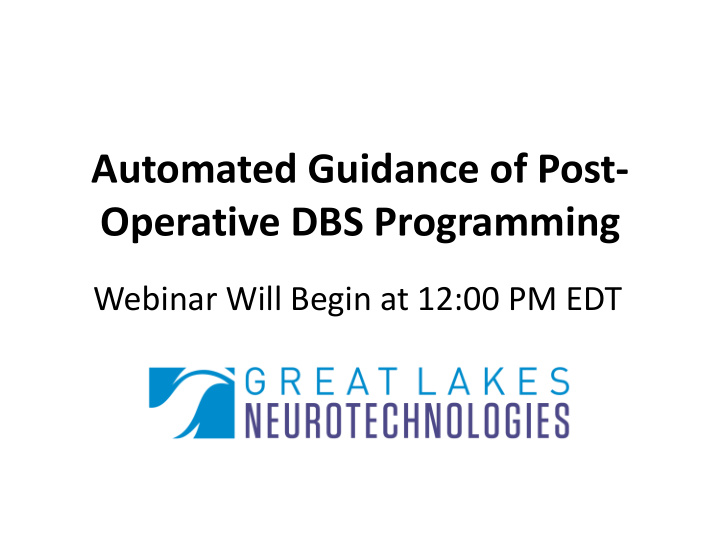



Automated Guidance of Post- Operative DBS Programming Webinar Will Begin at 12:00 PM EDT
Outline • Introduction to DBS • Challenges and Technological Opportunities – Kinesia ProView • Automated, Technology-Assisted DBS Programming
Deep Brain Stimulation • The clinical utility of DBS Lead deep brain stimulation DBS (DBS) for the treatment Electrodes of Parkinson’s disease is well established Extension Wire Implanted Pulse DBS OFF DBS ON Generator
DBS Programming Workflow Patient Clinician Programming IPG Unit
Challenges in DBS Clinician Training Vast Stimulation Parameter Space • Thousands of combinations of DBS • Great disparity in outcomes due to varied post-operative parameters (e.g., contact, polarity, management frequency, pulse width, amplitude)
Challenges in DBS Symptom Assessment Longitudinal Tracking • Documenting programming sessions • Not possible to evaluate all symptoms, lack of sensitivity in typically on paper, difficult to quickly clinical scales review history
DBS Programming Workflow Patient Clinician Programming IPG Unit
Algorithms for Symptom Rating • Automated algorithms for rating symptom severity: – Tremor – Dyskinesia – Upper Extremity Funding Over $25 Million Bradykinesia Collaborators – Lower Extremity Over 20 Collaborating Institutions Bradykinesia Publications Over 40 Peer-Reviewed & Presentations – Gait, Freezing of Gait
Kinematic DBS Response Bradykinesia tuning produces gradual, Tremor tuning produces sudden, dramatic fine effects on symptomatic benefit effects on symptomatic benefit
Tuning Maps Same effect with lower voltage? • Color-coded visualizations of DBS symptom response
DBS Programming Workflow Patient Clinician Programming IPG Unit
Kinesia ProView Objective quantification and visualization of deep brain stimulation response
HIPAA Compliant Log-in
Patient List
Tuning Map Home Screen
Stimulation Settings
Sensor-Based Assessment
Populated Tuning Map
DBS Programming Workflow Patient Clinician Programming IPG Unit
Automated DBS Programming 1. Motion sensor assessments to develop a functional map 2. Intelligent algorithms for navigating the parameter space to maximize symptomatic benefits while minimizing side effects and battery consumption
Value Proposition • Automated programming has potential benefits for both clinicians and patients Clinician Patient • Improved workflow • Improved outcomes • Improved patient outcome • Reduced battery tracking replacement • Expanded access • Reduced travel burden
Study Protocol • 9 PD subjects with DBS visit clinic at 1, 2, and 4 months post-implant • Conduct a standard monopolar review of parameter space • At each stimulation setting, assess tremor (rest and postural) and bradykinesia (finger tapping and pronation/supination) • Record final clinician-selected stimulation settings
DBS Functional Map
Parameter Optimization Analysis • Two algorithms were developed post-hoc to select the “optimal” stimulation contact and voltage combination across all motor tasks 1. Therapeutic benefit 2. Battery life • Relative effectiveness of settings determined by the clinician and those determined by each algorithm were compared
Optimization of Therapeutic Benefit • Increased therapeutic benefit relative to the clinician settings in 14/16 programming sessions – 31.7% vs 45.1% • Most often at expense of increase in stimulation amplitude
Optimization of Battery Life • Lower voltage while maintaining therapeutic benefit in 6/16 sessions – 50% reduction
Statistical Comparisons (paired t-tests)
Conclusions and Implications • Automated objective assessment in DBS programming can identify settings that: 1. Improve symptoms, or 2. Obtain similar benefit as clinicians with significant improvement in battery life • “Online” evaluation of automated guidance of DBS programming ongoing
Acknowledgements Jerrold Vitek, MD, PhD Tseganesh Orcutt, MSN Dustin Heldman, PhD Joseph Giuffrida, PhD Thomas Mera, MS Fredy Revilla, MD Enrique Urrea Mendoza, MD Maureen Gartner, MSN, NP-C NIH/NIA R44AG033520 NIH/NINDS R43NS081902 Erwin Montgomery, MD
Questions? Please contact: Christopher Pulliam, PhD Senior Biomedical Engineering Researcher cpulliam@glneurotech.com
Recommend
More recommend